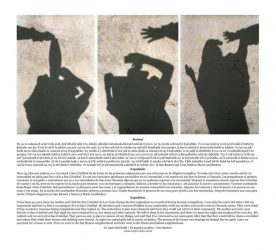Visual Arts Review: “Respeto/Respect” — A Conversation After Centuries of Silence
By Rebekah Bonner
Given the tensions in our current political and social environment, conversations and alliances such as these, that generate respect through listening to the voices of others, is essential.
Respeto/Respect at the Friends Meeting at Cambridge, through February 27. Hours (please call office to ensure availability at 617-876-6883): Weekdays except Wednesdays, 8 a.m.–4 p.m., and evenings except Wednesday, 6:30–8 pm; Saturdays, 8:30 a.m.–1 p.m.

Antonia Girón Intizin, 2012, Tenejapa during Todos Santos (All Saints and All Souls’ days), a soft drink offering to the dead. Photo: courtesy of Erica Adams.
Displayed in a Quaker establishment near Harvard Square, the exhibition Respeto/Respect presents a unique opportunity for dialogue, a look at the world through the lens of those who have experienced religious persecution — and are now free to practice their beliefs.
In 1992, artist and curator Carlota Duarte founded the Chiapas Photography Project (CPP), which is based in San Cristobal de las Casas, Mexico. She provided photographic equipment and instruction to the local Maya population. Since then, the project has grown, locally at first, then branching out. Today the CPP has generated a global audience. After decades of being represented and photographed by outsiders and tourists, the Mayan people have been given the means for self-expression, and an opportunity to document their own culture in which they can visually chronicle their lives in ways that engender cultural pride.
For many centuries, the people of southern Mexico have been beset with internal conflict over spiritual beliefs. The title of this exhibition refers to the search for peace and freedom through an acceptance of religious diversity. The show’s subjects include a baptism, a shrine, an offering, gatherings, and chapels; we see pictures of worshipers preparing food and drink offerings at altars during holy days, accompanied by trilingual translations of text from Maya to Spanish to English that recount prayers as well as stories of religious exile. One narrative elucidates “Jnutsel/Expulsion,” a series of three photos in which a woman’s shadow fends off disembodied, grasping, and darkened hands. Underneath we read about Juana Lopez Lopez, who was exiled from her home in San Juan Chamula 33 years ago after her family became evangelicals.
The photographs are not formally complicated; some are slightly blurry, a reminder of the technical limitations of the amateur photographers who shot them. Of course, what would be considered flaws in other exhibitions only serve to emphasize the contextual truth and goals of the CPP. (The slight shaking of a camera conveys more about the importance of this project than any elaborately prepared composition.) These photographers are citizens of their towns, documenting their religious lives as they happen, working to preserve their cultural and religious memories.

Erica H. Adams, artist, curator, and member of the local Quaker community, prepared the exhibit for the venue, while also compiling a binder of documents to accompany the photos. Supplying interviews and news articles on past religious tensions in Maya communities, these illuminating documents draw parallels between the Maya religious beliefs and Quaker practices for the benefit of the intended Quaker audience.
The “gallery” space at Friends Meeting is not ideal for viewing work. But, for all its faults, the venue is effective because, once you step into the building, you are aware that this space is closely associated with spirituality. The room is lined with chairs, tables, and a piano, interspersed with an occasional religious text. The lighting is standard fluorescent fare.The photo prints are fairly small; it takes close proximity to read the captions and text underneath them. This is a difficult task for some pieces, which are hung above chairs or tables; viewers are asked to weave in and out and around the furniture to read the texts.
In this way, Respeto/Respect becomes a kind of immersive installation: instead of a conventional window on another religious culture, the images form a bridge between one spiritual system and another, a hopeful meeting of minds and hearts. Given the tensions in our current political and social environment, conversations and alliances such as these, that generate respect through listening to the voices of others, is essential.
Rebekah Bonner is a practicing interdisciplinary artist who lives and works in the Cambridge/ Somerville area. Since earning her MFA in Visual Arts from Lesley University, she is very active in promoting, connecting, and creating opportunities for her fellow alumni and local artists.

THIS IS FOR REBEKAH BONNER
Thank you, Rebekah, for the article about the Respeto/Respect show at Friends Cambridge. I very much appreciate your sensitivity to the work made by the seven women participants in the exhibition and the importance and value of such a show, modest as it is, in the context of the current political and social environment.
You mention that I am a ‘professor’ – not so, though years ago, following my MFA from RISD, I was visiting lecturer at UMass Lowell.
Hi Carlota,
Thank you for this feedback. The article has been updated and corrections you mentioned have been made.
All the best!